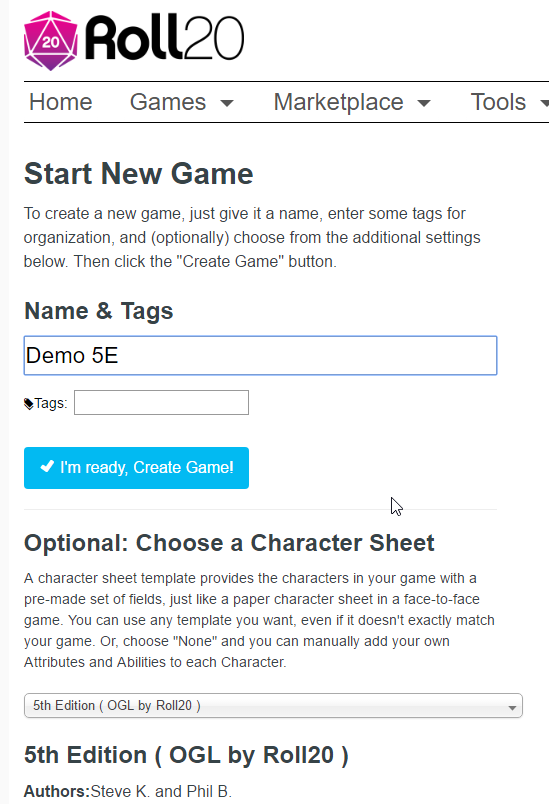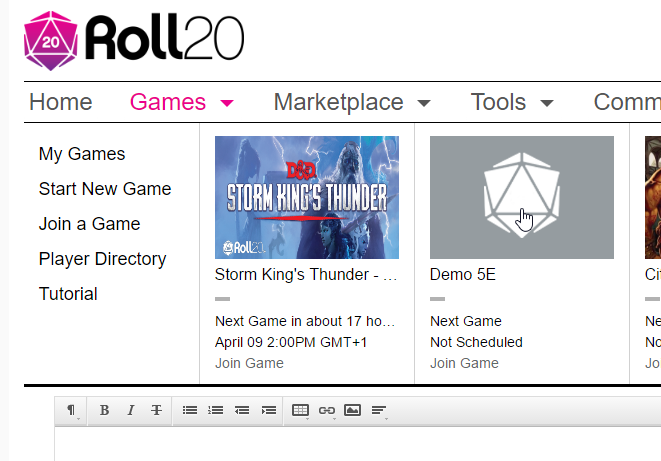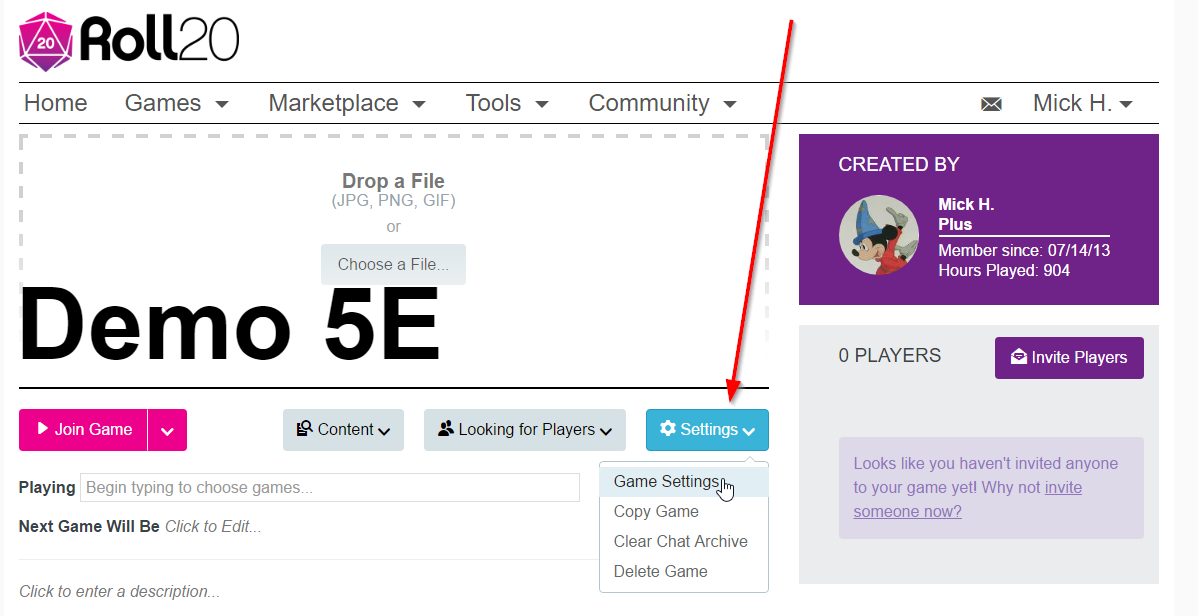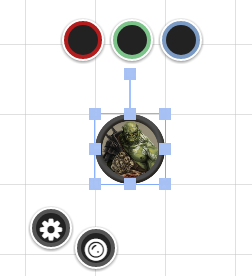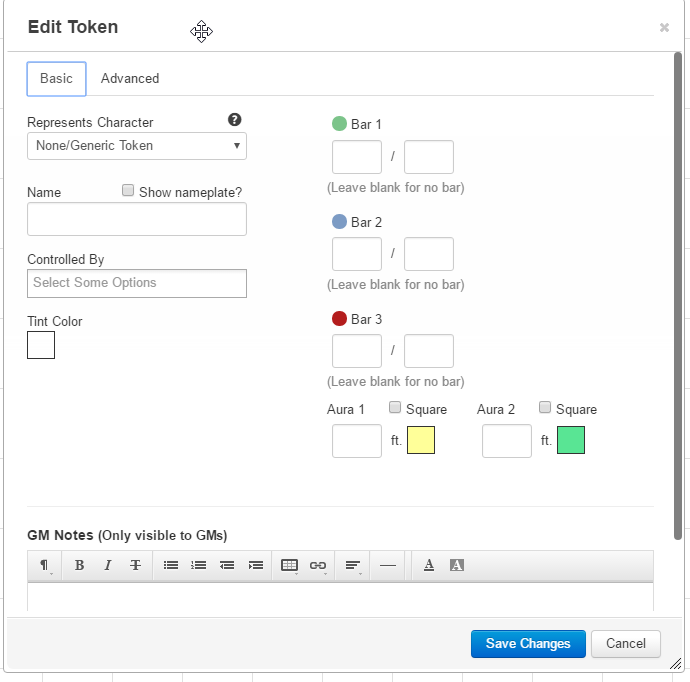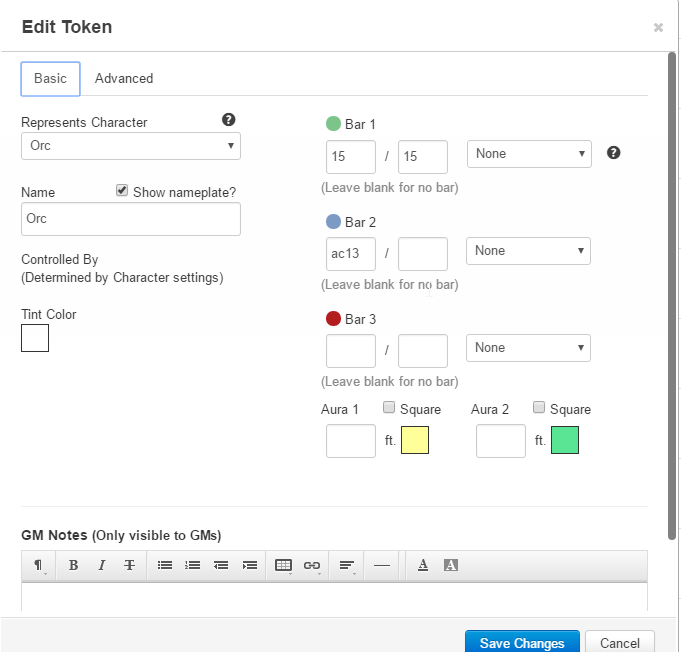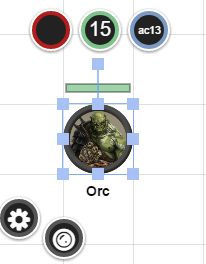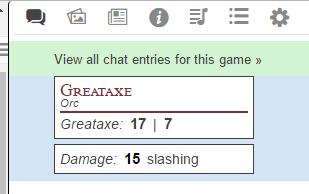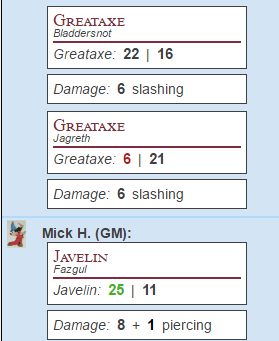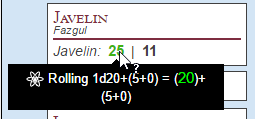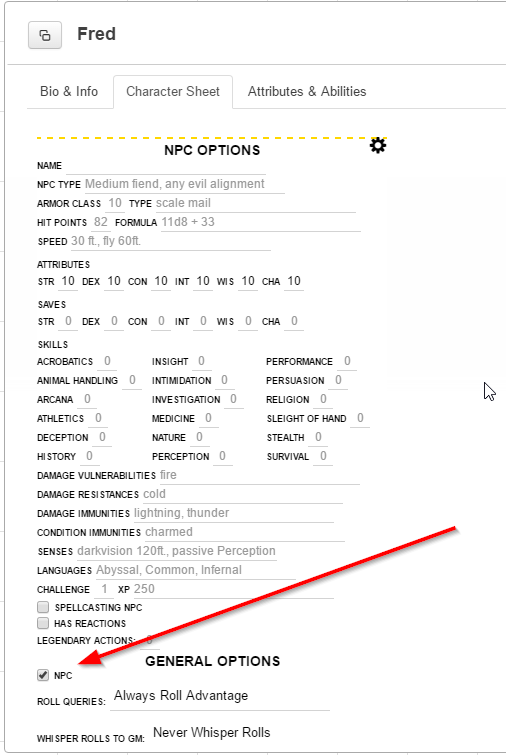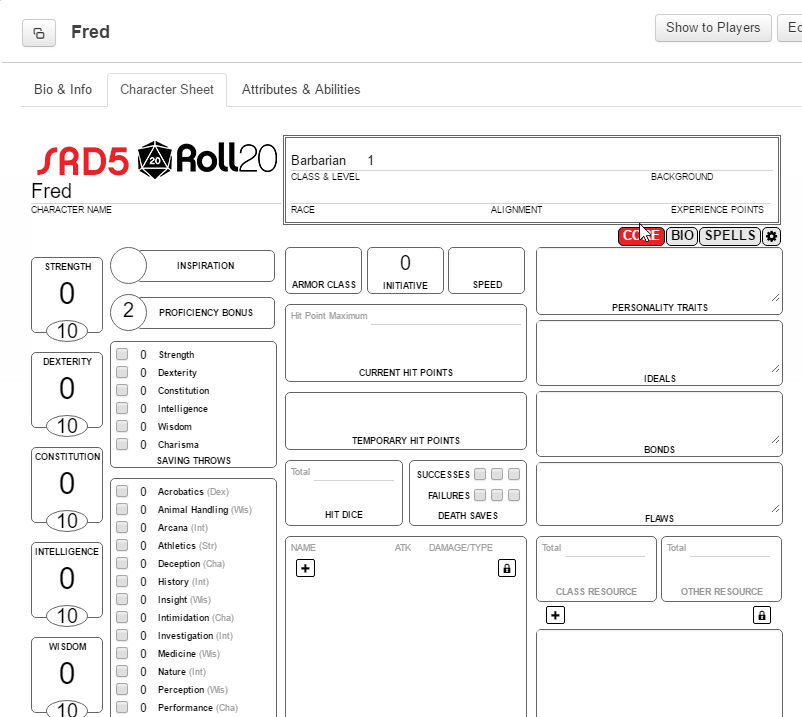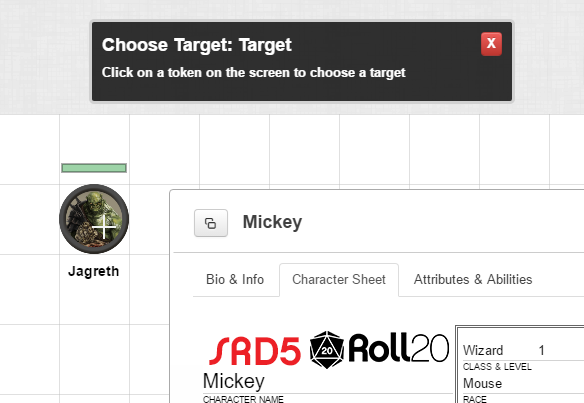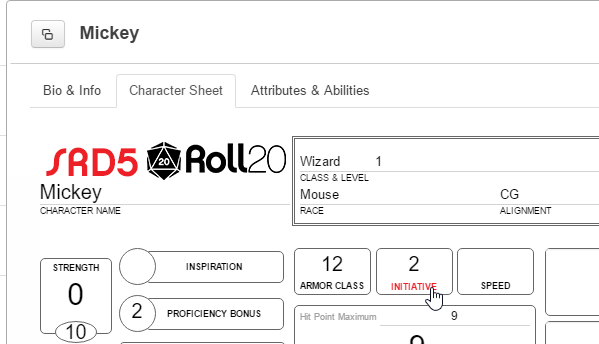Difference between revisions of "Running D&D5e on Roll20"
From Roll20 Wiki
m |
Andreas J. (Talk | contribs) m |
||
| (11 intermediate revisions by 3 users not shown) | |||
| Line 1: | Line 1: | ||
| − | ''' | + | {{cleanup-msg|'''Warning:''' This guide haven't been majorly updated since '''2017''', so other guides are recommended|March 2020}} |
| + | See '''[[Youtube#D&D 5E]]''' for more recent guides | ||
| + | __TOC__ | ||
| + | =Guide= | ||
| + | '''The following forewords are from the guide's original creator:''' | ||
| + | |||
| + | To find out something about my Role Playing Experience and get some generic DM Tips, please take a look at [[User:219283|Mick Hand's GM Tips]] | ||
| + | |||
| + | Although this seems like a large set of recommendations, '''DON'T PANIC'''. | ||
You don’t have to spend hours on end preparing each game session. | You don’t have to spend hours on end preparing each game session. | ||
| Line 8: | Line 16: | ||
To be absolutely honest, I have spent a lot longer than this preparing for my D&D 5E games but since Roll20 introduced the Compendium and the ability to drag monster info from the compendium, it has got a lot quicker. | To be absolutely honest, I have spent a lot longer than this preparing for my D&D 5E games but since Roll20 introduced the Compendium and the ability to drag monster info from the compendium, it has got a lot quicker. | ||
| − | |||
| − | |||
| − | |||
| − | |||
| − | |||
| − | [[File:DnD_Start_Game.png]] | + | ==Creating the Campaign== |
| + | From the “Start New Game” option… | ||
| + | |||
| + | # Enter the name for your Campaign | ||
| + | # Choose the Character Sheet called “[[D&D 5E by Roll20]]” | ||
| + | # Click “I’m Ready, Create Game” | ||
| + | [[File:DnD_Start_Game.png|400px]] | ||
As soon as you have clicked “I’m Ready, Create Game”, you will Join the Game as the GM. You are taken to an empty page. | As soon as you have clicked “I’m Ready, Create Game”, you will Join the Game as the GM. You are taken to an empty page. | ||
| Line 25: | Line 34: | ||
This takes you to the “Thank you for playing….” Screen. There’s no need to fill anything in there yet, so just hover over “Games” to see a list of your recent games and click on the image for the one you just created (in my case this was “Demo 5E”) | This takes you to the “Thank you for playing….” Screen. There’s no need to fill anything in there yet, so just hover over “Games” to see a list of your recent games and click on the image for the one you just created (in my case this was “Demo 5E”) | ||
| − | [[File:DnD_Choose_Game.png]] | + | [[File:DnD_Choose_Game.png|500px]] |
From the main Game page, choose the “Settings” option and then choose “Game Settings". | From the main Game page, choose the “Settings” option and then choose “Game Settings". | ||
| − | [[File:DnD_Game_Settings.png]] | + | [[File:DnD_Game_Settings.png|500px]] |
The Game Settings page has lots of useful info on it – here are my recommendations for a D&D5E game... | The Game Settings page has lots of useful info on it – here are my recommendations for a D&D5E game... | ||
| Line 51: | Line 60: | ||
Allow players to import their own Characters = <span style="color:red">YES</span> | Allow players to import their own Characters = <span style="color:red">YES</span> | ||
Access Compendium In-Game = Determined by Character Sheet (Default) | Access Compendium In-Game = Determined by Character Sheet (Default) | ||
| − | Character Sheet Template = | + | Character Sheet Template = '''D&D 5E by Roll20''' |
In the Default sheet Settings… | In the Default sheet Settings… | ||
NPC = Ticked | NPC = Ticked | ||
| Line 95: | Line 104: | ||
I recommend <span style="color:red">'''not'''</span> ticking the Automatically roll 3D Dice. | I recommend <span style="color:red">'''not'''</span> ticking the Automatically roll 3D Dice. | ||
| − | + | ==Adding Monsters== | |
The Roll20 Compendium for D&D5E has made a big difference to the amount of work a DM has to do to put monsters | The Roll20 Compendium for D&D5E has made a big difference to the amount of work a DM has to do to put monsters | ||
into their game - with all their Stats and with clickable Attacks and Saves and Initiative. | into their game - with all their Stats and with clickable Attacks and Saves and Initiative. | ||
| Line 101: | Line 110: | ||
you do have to do a little bit of work for each Monster... | you do have to do a little bit of work for each Monster... | ||
| − | + | ===Getting a Monster from the Compendium to appear as a “Character” in your game’s Journal=== | |
1. Go to the (i) symbol in the side bar, this opens the Compendium. | 1. Go to the (i) symbol in the side bar, this opens the Compendium. | ||
| Line 139: | Line 148: | ||
they won’t immediately know if it is a zombie or a ghoul or something else. | they won’t immediately know if it is a zombie or a ghoul or something else. | ||
| − | + | ===Dropping a Token into your game and associating it with a Monster from your Journal=== | |
Hit the i key and the side bar will switch to display the Art Library. Or you can just click on the Art icon. | Hit the i key and the side bar will switch to display the Art Library. Or you can just click on the Art icon. | ||
| Line 153: | Line 162: | ||
Clicking on the Cog will launch the “Edit Token” screen. | Clicking on the Cog will launch the “Edit Token” screen. | ||
| − | [[File:DnD_Edit_Token.png]] | + | [[File:DnD_Edit_Token.png|450px]] |
Use the drop down list at the top left “Represents Character” to associate this Token with the Journal entry for “Orc”. | Use the drop down list at the top left “Represents Character” to associate this Token with the Journal entry for “Orc”. | ||
| Line 163: | Line 172: | ||
If you know the Armour Class of the orc, fill it in in the first box for “Bar2” as ac13. | If you know the Armour Class of the orc, fill it in in the first box for “Bar2” as ac13. | ||
| − | [[File:DnD_Edit_Token_Orc.png]] | + | [[File:DnD_Edit_Token_Orc.png|450px]] |
Click “'''Save Changes'''”. | Click “'''Save Changes'''”. | ||
| Line 244: | Line 253: | ||
[[File:DnD_Roll_Hover_03.png]] | [[File:DnD_Roll_Hover_03.png]] | ||
| − | + | ===Quick access to the Monster Character Sheets=== | |
As mentioned above, you can Shift+Double-click on a Token to launch its Journal Entry (containing its character sheet). | As mentioned above, you can Shift+Double-click on a Token to launch its Journal Entry (containing its character sheet). | ||
| Line 261: | Line 270: | ||
telling you which Token name made the roll – Fazgul, Jagreth or Bladdersnot. | telling you which Token name made the roll – Fazgul, Jagreth or Bladdersnot. | ||
| − | + | ==Rolling for Initiative== | |
Open the “Turn Order” window by typing “y” in the main window or by clicking the clock icon in the floating toolbox. | Open the “Turn Order” window by typing “y” in the main window or by clicking the clock icon in the floating toolbox. | ||
| Line 280: | Line 289: | ||
and editing it to have an R after the number. | and editing it to have an R after the number. | ||
| − | + | ==Keeping Track of Time== | |
If there is a spell you need to track the rounds for, you can add it to the “Turn Order” by clicking on the cog | If there is a spell you need to track the rounds for, you can add it to the “Turn Order” by clicking on the cog | ||
| Line 291: | Line 300: | ||
Hovering over a monster entry in the Turn Order will highlight the Token on the Map. | Hovering over a monster entry in the Turn Order will highlight the Token on the Map. | ||
| − | + | ==Setting up a character for a Player Character== | |
Player Characters are created in the Journal by clicking the “+Add” button and then selecting “Character”. | Player Characters are created in the Journal by clicking the “+Add” button and then selecting “Character”. | ||
| Line 342: | Line 351: | ||
Then make that token the Default Token for the PC by clicking the "Use Selected Token" option. | Then make that token the Default Token for the PC by clicking the "Use Selected Token" option. | ||
| − | + | ===Adding Weapons to a PC Character Sheet=== | |
Recommend setting the Description of the attack to say… | Recommend setting the Description of the attack to say… | ||
| − | Target @{ | + | Target @{target|token_name} |
This will force the Player to select the target... | This will force the Player to select the target... | ||
| Line 360: | Line 369: | ||
[[File:DnD_PC_Initiative.png]] | [[File:DnD_PC_Initiative.png]] | ||
| − | + | ==Adding Macros that can be used by both the GM and Players== | |
My recommendation is to add a couple of Macros to make things quicker for the Players | My recommendation is to add a couple of Macros to make things quicker for the Players | ||
| Line 374: | Line 383: | ||
'''Initiative''' | '''Initiative''' | ||
| − | + | <code> @{selected|token_name} Initiative [[1d20 + @{selected|initiative_bonus} &{tracker}]] </code> | |
'''Perception''' | '''Perception''' | ||
| − | + | <code> @{selected|token_name} Perception [[1d20 + @{selected|perception_bonus}]] </code> | |
| + | |||
| + | |||
| + | =Related pages= | ||
| + | * '''[[D&D 5E by Roll20]]''' (AKA. "5th Edition OGL"), the Official 5E character sheet which includes the Charactermancer, and is by far the most used 5e sheet. This guide was made with a older version of the sheet. | ||
| + | * [[5E]] - Lists the other D&D5E character sheets available on Roll20. | ||
| + | * [[Game Management]] | ||
| + | * [[Youtube#]] - many guides for playing on Roll20 | ||
| + | * [[Subscription]] | [[Free]] vs. [[Plus]] & [[Pro]] | ||
| + | |||
| − | + | <br> | |
| + | <br> | ||
| + | [[Category:Games]] | ||
| + | [[Category:DnD5E]] | ||
Latest revision as of 13:02, 22 October 2021
| Warning: This guide haven't been majorly updated since 2017, so other guides are recommended (March 2020) |
See Youtube#D&D 5E for more recent guides
Contents |
[edit] Guide
The following forewords are from the guide's original creator:
To find out something about my Role Playing Experience and get some generic DM Tips, please take a look at Mick Hand's GM Tips
Although this seems like a large set of recommendations, DON'T PANIC.
You don’t have to spend hours on end preparing each game session.
Realistically, you should probably expect to spend a few hours preparing your first one and then maybe you could cut back to about 1 hour technical prep for a 4-hr game session. You should do a bit of practice with the Monsters, Maps, Dice rolling and Tokens before you start playing the game for real. To be absolutely honest, I have spent a lot longer than this preparing for my D&D 5E games but since Roll20 introduced the Compendium and the ability to drag monster info from the compendium, it has got a lot quicker.
[edit] Creating the Campaign
From the “Start New Game” option…
- Enter the name for your Campaign
- Choose the Character Sheet called “D&D 5E by Roll20”
- Click “I’m Ready, Create Game”
As soon as you have clicked “I’m Ready, Create Game”, you will Join the Game as the GM. You are taken to an empty page. Before you do anything else, it is worth exiting the game and then going to the “Game Settings” page to set up some default settings.
Click the Cog Icon on the far right to get to the “My Settings” section Click the “Exit Game” button at the top of the “My Settings” section.
This takes you to the “Thank you for playing….” Screen. There’s no need to fill anything in there yet, so just hover over “Games” to see a list of your recent games and click on the image for the one you just created (in my case this was “Demo 5E”)
From the main Game page, choose the “Settings” option and then choose “Game Settings".
The Game Settings page has lots of useful info on it – here are my recommendations for a D&D5E game...
This page works a bit strangely, so my advice is to Expand the “Game Default Settings” by clicking on it and this opens up a lot more defaults…
Some people like to set the “Page Defaults-->Background” to some pale colour other than white, as bright white screens are meant to be bad for our eyes. In the Player Permissions… Name = Tick the “See” option Bar 1 = Tick the “See” option CLICK “Save Defaults”
After it saves the “Game Default Settings” it will close that section. Now, after saving the “Game Default Settings”, you can change the other settings on the page. If you change other settings before saving the “Game Default Settings” section, it seems to reset the other settings!
The settings in red below are ones I always change from the current defaults …
Allow Public Access to this game = NO Allow players to import their own Characters = YES Access Compendium In-Game = Determined by Character Sheet (Default) Character Sheet Template = D&D 5E by Roll20 In the Default sheet Settings… NPC = Ticked ROLL QUERIES = Always Roll Advantage WHISPER ROLLS TO GM = Never Whisper Rolls If you think you will want to make a lot of rolls in secret, it is OK to set this to “Query Whisper Rolls” instead. You might get fed up with this option, but if you want to roll Initiative for monsters the PCs can’t see yet, it can be useful. If you choose the “Query Whisper” option, each time you make an attack roll from a Monster character sheet, it will ask if you want it to be public. You can just hit return for most of them, but when you want a secret roll, just toggle the value to “Whisper” instead. I prefer to “Never Whisper Rolls” and might write a macro (or even roll a physical dice) for something that I don’t want the players to see). I’ll cover creating a Whispered Macro for Initiative later. AUTO DAMAGE ROLL = Auto Roll Damage & Crit ADD CHARACTER NAME TO TEMPLATES = On INVENTORY = Compendium Compatible ENCUMBERANCE = Off AMMO TRACKING = Off
Click “Save Changes” at the bottom of the screen.
Now you are ready to “Join the Game” again. This time, head to the Cog Icon and set a few things in the “My Settings” section. These settings will be remembered next time you Join the Game so you shouldn’t have to change them again.
I very much recommend ticking the “Use advanced keyboard shortcuts”.
I recommend not ticking the “Use window popouts for characters”. This is purely because of using the earlier option about “Query Whisper Rolls” or if you later write Macros that ask you to choose or fill-in something. If you use Window Popouts, then the focus isn’t on the main Roll20 Window and the dialog that asks whether to make this a public or whispered roll will appear behind the character sheet and won’t automatically have focus so you can just hit return.
I recommend not ticking the Enable Advanced Dice.
I recommend not ticking the Enable 3D Dice. While some people like to see “real” dice being thrown, it does seem to slow the game slightly and can cause confusion when a D20 shows a 20 but you were rolling with disadvantage and can’t see where the other D20 landed.
I recommend not ticking the Automatically roll 3D Dice.
[edit] Adding Monsters
The Roll20 Compendium for D&D5E has made a big difference to the amount of work a DM has to do to put monsters into their game - with all their Stats and with clickable Attacks and Saves and Initiative. However, to get the best out of it (make it quick to use during the game), you do have to do a little bit of work for each Monster...
[edit] Getting a Monster from the Compendium to appear as a “Character” in your game’s Journal
1. Go to the (i) symbol in the side bar, this opens the Compendium.
2. Type in the word orc – this will list all compendium items having orc in the title.
3. Click and hold on the name of the monster and drag it onto the main page and let go.
4. This will open the Monster’s character sheet, showing the “Bio & Info” page.
5. Click on the “Character Sheet” tab.
6. Hover over the red name “Orc” and a small cog will appear to the right. You can click this in order to open the “NPC Options” for editing.
7. Replace the name Orc with
@{selected|token_name}
There are no spaces, the line after the word “selected” is a “pipe” character, there is an underscore between “token” and “name” and the brackets are the curly ones. You’ll see exactly why we are doing this later. It’s to enable multiple tokens to use the same NPC character sheet, but to show the Token’s name rather than just the word “orc” when you make dice rolls for them.
8. Click on the small cog again to close the NPC Options.
9. Close the character sheet for the Orc.
10. Click on the Journal Icon in the sidebar to switch to your Journal section, you will see that your copy of the Orc has appeared in your Journal.
I ALWAYS use a Token for monsters and never use a monster without a Token. The trick described above for getting the Token’s Name to appear in the chat with any Rolls, means the rolls won’t work if there is no Token Selected. If you do need to use a monster without a Token, just open it direct from the compendium again rather than using the one you have created in your Journal.
This trick of using the Token name not only lets you easily see in the Chat which Orc made the rolls but also means you aren’t showing the Players the exact type of monster. So if you have a shambling undead creature they won’t immediately know if it is a zombie or a ghoul or something else.
[edit] Dropping a Token into your game and associating it with a Monster from your Journal
Hit the i key and the side bar will switch to display the Art Library. Or you can just click on the Art icon.
Type the word “orc” into the search box and some pictures of Orcs should show up.
Grab one and drag it onto the main page and let go.
This should add a Token. If you click on it, you should see its handles and bars appear.
Clicking on the Cog will launch the “Edit Token” screen.
Use the drop down list at the top left “Represents Character” to associate this Token with the Journal entry for “Orc”.
Tick the “Show Nameplate?” and type in a name for this token. You can leave it as Orc for now.
If you know the Hit Points of the orc, fill them in in the two boxes for “Bar 1” as 15 and 15
If you know the Armour Class of the orc, fill it in in the first box for “Bar2” as ac13.
Click “Save Changes”.
Clicking on the Token should now show the health bar, the current hitpoints (15) and the armour class (ac13).
The Players won’t be able to select the Orc, so will only see the health bar, not the number and won’t see the AC.
Now that this token is associated with the Orc in your Journal, you can launch its character sheet by doing Shift+Double-click on the token.
Launch the character sheet and click the “Edit” button in the top right.
This will show the Option for an “Avatar” – this just means a picture to show in the Journal. You can drag the same token picture from your Art Library to make that the default picture of an Orc in your Journal listing. Underneath the Avatar is a “Default Token (Optional)” with a white space under it.
Hover over the white space and the option to “Remove” the current default token will appear. For some reason, the items from the Compendium seem to have a blank image for each monster so you have to remove it before you can add one. Then make sure you still have your Orc Token selected on the main page and click “Use Selected Token”.
Click to “Save Changes” and then close the character sheet and delete the Token from your main page.
Now your “Orc” will appear in your Journal with an image and, if you drag from the Journal onto your main page, it will create an exact copy of that original Token. Drag it again to create another and again to create another.
Now you have 3 Orcs ready to attack your Player Characters.
Shift+Double-click an Orc to get the character sheet to appear, switch to the character sheet tab and then click on the “Greataxe”.
If you don’t already have the Chat window open you can click “c” to make it appear.
As you can see in the Chat, the Orc rolled a 17 and then did a massive 15 damage (ouch!).
If you followed all my set-up advice, the system is configured to always roll two dice. Use the first result (17) unless the creature has either Advantage or Disadvantage (in which case you either use the highest or lowest of the two results).
The system is also configured to roll the damage at the same time.
The system is also configured to show the name of the creature “Orc” in the chat window, but all three of my tokens have the same name!
Move the character sheet to one side and edit the Tokens (hover over one and click the Cog). Change the names from “Orc” to “Fazgul”, “Jagreth” and “Bladdersnot”.
Now you can click on one and then use the Greataxe and it should show you the name of the currently selected token.
Bladdersnot hit AC22 and did 6 damage. Jagreth rolled a natural one (the dice roll shows as red).
Fazgul rolled a natural 20 (the dice roll shows in green) with his javelin attack. Notice that his damage shows the extra critical damage too.
New DMs should be careful when reading the critical damage as the crit damage is shown even if it is the second dice that gets a 20, but you only use the second dice when it is relevant. Because Advantage and Disadvantage are so common in D&D5E, you’ll soon get the hang of when to count the extra damage and which of the two results to ignore.
At any time, you can hover the mouse cursor over a Dice Roll result and it will show you what dice were rolled and what modifiers were added.
If I hover over Fazgul’s Javelin attack rolls, you can see that the 25 shows Fazgul is adding +5 to the 1d20 roll to hit.
If I hover over the Damage 8 it shows Fazgul is adding 3 to the 1d6 damage and he rolled a 5
If I hover over the Damage +1, it shows the extra critical damage was 1d6 and he rolled a 1
[edit] Quick access to the Monster Character Sheets
As mentioned above, you can Shift+Double-click on a Token to launch its Journal Entry (containing its character sheet). Once you have launched the Journal Entry, switch to the character sheet tab to show the Attacks and stats. You can double-click on the white-space at the top of the dialog (to the right of the Monster’s Name and to left of the “Show To Players” button). This will minimize the character sheet into a very faint little label. Double-clicking on the label will open the sheet again. You can open the character sheets for all the monster types in your current encounter and position them somewhere for quick access. You don’t need one sheet for each token, just one for each type of monster, so if my encounter had 3 orcs and one Dire Wolf, I’d open an Orc sheet and a Dire Wolf sheet and keep them minimized at the top of my screen.
When you intend to make an attack roll or Initiative roll or Saving Throw, from the Orc sheet, select the Token first. If the character sheet is already on the page (minimized) double click on it to open it again. If the sheet isn’t open already, Shift+double-click the token to open its sheet. Then click on the attack, or the ability to make the roll and it will appear in the chat box, telling you which Token name made the roll – Fazgul, Jagreth or Bladdersnot.
[edit] Rolling for Initiative
Open the “Turn Order” window by typing “y” in the main window or by clicking the clock icon in the floating toolbox.
For some reason, there is no obvious Initiative button in the sheets. To roll initiative, SELECT THE TOKEN, then open the character sheet and click on the Name – if you followed my suggestions, this will appear to be
@{SELECTED|TOKEN_NAME}
I usually use the same initiative for all monsters of the same type. If you do this, don’t delete the monster tokens when they die (in case the PCs kill the “initiative token”). Just use the token symbols button to stick a big red X on dead ones and/or drag the body out of sight). If you prefer to give each monster a separate initiative, just select a different token and click the name in the character sheet.
In D&D5E, the initiative order does not change. Creatures can READY but there is no DELAY Action (as there used to be in previous editions of D&D). If a creature (or a PC) decides to READY, you can indicate this in the “Turn Order” window by clicking on their score and editing it to have an R after the number.
[edit] Keeping Track of Time
If there is a spell you need to track the rounds for, you can add it to the “Turn Order” by clicking on the cog at the bottom of the “Turn Order” and then fill in the name of the spell in the “Add Custom Item” section and putting -1 in the lower box, then click Add. Your item will jump into the “Turn Order” with a value of 0. Drag it to the point in the “Turn Order” it needs to be and then click on its score and enter the number of rounds it is supposed to last. As you cycle through the “Turn Order” using the right arrow button at the bottom, the score for the Spell will reduce by 1 each time. When it gets to zero, you know the spell has run out. Hovering over a monster entry in the Turn Order will highlight the Token on the Map.
[edit] Setting up a character for a Player Character
Player Characters are created in the Journal by clicking the “+Add” button and then selecting “Character”. This opens a Creature dialog box with a random name. I usually type the name of the Player in there unless I already know the name of their character.
Set the “In Player’s Journals” to “All Players”
If your players have already joined the game, you can set the “Can Be Edited & Controlled By” to be the specific Player, otherwise leave this blank until they have joined. They can join and exit at times when you are not connected and as long as they have joined at least once, you can grant them control by changing the “Can Be Edited & Controlled By”.
Click “Save Changes”
This makes the Character visible in the Journal.
We set the default to be adding NPC creatures (because you will be adding a lot more NPCs than PCs). Because of this, you will need to go to the “Character Sheet” tab and about half way down there is a section called “General Options” that has a tick against “NPC”.
UN-Tick it, and the display will change to a proper PC Character Sheet.
Assigning the PC to a Token
Add a token from the Art Library
Edit the Token by selecting it and using its Cog.
Associating the Token with the Journal Entry is done by setting the “Represents Character” option.
Set the Hit Points Bar to represent the Hit Points from the Character Sheet by entering hp and hp in the two entries for Bar 1.
On the second tab page of the Token properties, make everything else visible to Players (other bars, auras).
If you intend to use the Dynamic Lighting feature (“Subscriber” or “Pro” subscription required), set the Token to be able to See by ticking “Has Sight”. Set the Token to have Dark Vision (if it should have) usually this means setting the Has Light option to 60 feet and NOT ticking the “All Players See Light”
Save Changes.
Finally, make sure you have the Token selected (after setting all the above) and open the Journal entry for that character and click the Edit button at the top right. Then make that token the Default Token for the PC by clicking the "Use Selected Token" option.
[edit] Adding Weapons to a PC Character Sheet
Recommend setting the Description of the attack to say…
Target @{target|token_name}
This will force the Player to select the target...
...and then show the name of the target in the chat window as part of the roll…
PC Rolling Initiative
You can open your character sheet and click on the word “Initiative” in the Character Sheet.
[edit] Adding Macros that can be used by both the GM and Players
My recommendation is to add a couple of Macros to make things quicker for the Players so they don’t need to open their character sheets when you ask for one of the common rolls (such as Initiative and Perception)
Add these Macros as the GM but click the checkbox for “Token Action” and set them to be visible to ALL PLAYERS.
Initiative
@{selected|token_name} Initiative [[1d20 + @{selected|initiative_bonus} &{tracker}]]
Perception
@{selected|token_name} Perception [[1d20 + @{selected|perception_bonus}]]
[edit] Related pages
- D&D 5E by Roll20 (AKA. "5th Edition OGL"), the Official 5E character sheet which includes the Charactermancer, and is by far the most used 5e sheet. This guide was made with a older version of the sheet.
- 5E - Lists the other D&D5E character sheets available on Roll20.
- Game Management
- Youtube# - many guides for playing on Roll20
- Subscription | Free vs. Plus & Pro





